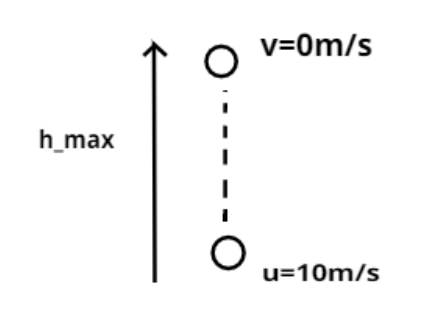
A body is projected vertically upwards with a velocity of 10m/s. The maximum height reached by the body is :
$
(a){\text{ 5m}} \\
(b){\text{ 2m}} \\
(c){\text{ 1m}} \\
(d){\text{ 100m}} \\
$
Answer
217.8k+ views
Hint: In this question use the equation of the third law of the motion that is ${v^2} = {u^2} + 2as$, since at the maximum height the final velocity of the body will be zero therefore use this concept to find the maximum height attained by the body.
Complete step-by-step solution -

According to third law of motion we have,
${v^2} = {u^2} + 2as$.............. (1)
Where, v = final velocity of the particle, u = initial velocity of the particle, a = acceleration of the particle and s = distance travelled by the particle.
Now it is given that a body is projected vertically upwards with a velocity of 10m/s.
So the initial velocity of the body is, u = 10m/s
After reaching the maximum height final velocity of the body becomes zero and at this point acceleration due to gravity is maximum and working downwards so a = -g = -10 m/s2.
So s becomes ${H_{\max }}$
Now substitute the value in equation (1) we have,
$ \Rightarrow 0 = {\left( {10} \right)^2} + 2\left( { - g} \right){H_{\max }}$
$ \Rightarrow 2g{H_{\max }} = 100$
$ \Rightarrow {H_{\max }} = \dfrac{{100}}{{2 \times 10}} = 5$m.
So the maximum height reached by the body when it is thrown vertically upwards with a velocity of 10m/s is 5 m.
So this is the required answer.
Hence option (A) is the correct answer.
Note – The trick point here was that the acceleration due to gravity is taken as negative as positive upwards that is y direction is considered as positive however g will be acting in downwards or negative y direction thus it is taken as negative. The equation of motion is valid if and only if the acceleration remains constant all throughout the journey of the body and since it was constant as g and thus the laws of motions are applicable. The equation of motion other than ${v^2} - {u^2} = 2as$ are $v = u + at{\text{ and s = ut + }}\dfrac{1}{2}a{t^2}$.
Complete step-by-step solution -

According to third law of motion we have,
${v^2} = {u^2} + 2as$.............. (1)
Where, v = final velocity of the particle, u = initial velocity of the particle, a = acceleration of the particle and s = distance travelled by the particle.
Now it is given that a body is projected vertically upwards with a velocity of 10m/s.
So the initial velocity of the body is, u = 10m/s
After reaching the maximum height final velocity of the body becomes zero and at this point acceleration due to gravity is maximum and working downwards so a = -g = -10 m/s2.
So s becomes ${H_{\max }}$
Now substitute the value in equation (1) we have,
$ \Rightarrow 0 = {\left( {10} \right)^2} + 2\left( { - g} \right){H_{\max }}$
$ \Rightarrow 2g{H_{\max }} = 100$
$ \Rightarrow {H_{\max }} = \dfrac{{100}}{{2 \times 10}} = 5$m.
So the maximum height reached by the body when it is thrown vertically upwards with a velocity of 10m/s is 5 m.
So this is the required answer.
Hence option (A) is the correct answer.
Note – The trick point here was that the acceleration due to gravity is taken as negative as positive upwards that is y direction is considered as positive however g will be acting in downwards or negative y direction thus it is taken as negative. The equation of motion is valid if and only if the acceleration remains constant all throughout the journey of the body and since it was constant as g and thus the laws of motions are applicable. The equation of motion other than ${v^2} - {u^2} = 2as$ are $v = u + at{\text{ and s = ut + }}\dfrac{1}{2}a{t^2}$.
Recently Updated Pages
Arithmetic, Geometric & Harmonic Progressions Explained

Cartesian Form of Vector Explained: Formula, Examples & Uses

Apparent Frequency Explained: Formula, Uses & Examples

Calorimetry: Definition, Principles & Calculations

Centrifugal Force Explained: Definition, Formula & Examples

Charge in a Magnetic Field: Definition, Formula & Examples

Trending doubts
JEE Main 2026: Application Form Open, Exam Dates, Syllabus, Eligibility & Question Papers

Derivation of Equation of Trajectory Explained for Students

Hybridisation in Chemistry – Concept, Types & Applications

Understanding the Angle of Deviation in a Prism

Understanding Collisions: Types and Examples for Students

Understanding Atomic Structure for Beginners

Other Pages
JEE Advanced Marks vs Ranks 2025: Understanding Category-wise Qualifying Marks and Previous Year Cut-offs

Units And Measurements Class 11 Physics Chapter 1 CBSE Notes - 2025-26

NCERT Solutions For Class 11 Physics Chapter 8 Mechanical Properties Of Solids

Motion in a Straight Line Class 11 Physics Chapter 2 CBSE Notes - 2025-26

NCERT Solutions for Class 11 Physics Chapter 7 Gravitation 2025-26

How to Convert a Galvanometer into an Ammeter or Voltmeter




